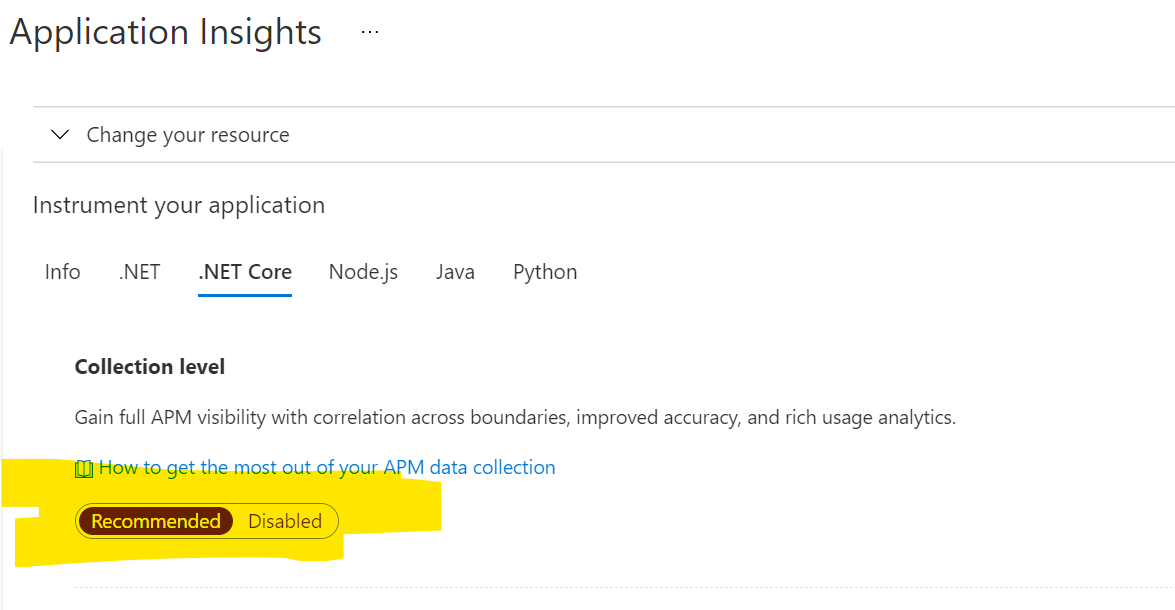Hi!
We run an ABP application hosted in an Azure App Service. Everything works fine but when we enable this setting
 in Application Insights we can no longer access the login page (
in Application Insights we can no longer access the login page (/Account/Login) and the application seems to crash when we try to load the login page. This is logged:
2021-12-23 16:52:48.465 +00:00 [INF] Request starting HTTP/1.1 GET https://www.example.com/Account/Login - -
2021-12-23 16:52:48.631 +00:00 [INF] Executing endpoint '/Account/Login'
2021-12-23 16:52:48.787 +00:00 [INF] Route matched with {page = "/Account/Login", action = "", controller = "", area = ""}. Executing page /Account/Login
2021-12-23 16:53:15.770 +00:00 [INF] Azure Web Sites environment detected. Using 'C:\home\ASP.NET\DataProtection-Keys' as key repository; keys will not be encrypted at rest.
2021-12-23 16:53:33.872 +00:00 [INF] Application started. Press Ctrl+C to shut down.
2021-12-23 16:53:33.874 +00:00 [INF] Hosting environment: Production
2021-12-23 16:53:33.874 +00:00 [INF] Content root path: C:\home\site\wwwroot
The start page is still working fine. Any ideas what is happening here?
Thanks, we'll look into that. Is there no way to add extra fields to the token error response?
We would like our front-end to be able to determine why the user was unable to authenticate and display the appropriate message, e.g. to send an email confirmation token if the email has not been verified.
Hi!
Is there any way we can customize the error response from the /connect/token endpoint depending on what kind of error did occur? For example right now the only way to determine if the user's password is incorrect or if the user has not yet verified their email address is to look at the error_description field (which should not be used to react to errors).
// Incorrect password:
{
"error": "invalid_grant",
"error_description": "Invalid username or password!"
}
// Not verified email address:
{
"error": "invalid_grant",
"error_description": "You are not allowed to login! You need to confirm your email/phone number."
}
Thank you for answering.
Hi,
Is ABP v4.4.x fully compatible with .NET 6?
Hi,
We're getting this error message when running ef migrations and can't figure out why. Any pointers where we should look`?
The property 'AppUser.ExtraProperties' could not be mapped because it is of type 'ExtraPropertyDictionary', which is not a supported primitive type or a valid entity type. Either explicitly map this property, or ignore it using the '[NotMapped]' attribute or by using 'EntityTypeBuilder.Ignore' in 'OnModelCreating'
> dotnet ef migrations list
Build started...
Build succeeded.
System.InvalidOperationException: The property 'AppUser.ExtraProperties' could not be mapped because it is of type 'ExtraPropertyDictionary', which is not a supported primitive type or a valid entity type. Either explicitly map this property, or ignore it using the '[NotMapped]' attribute or by using 'EntityTypeBuilder.Ignore' in 'OnModelCreating'.
at Microsoft.EntityFrameworkCore.Infrastructure.ModelValidator.ValidatePropertyMapping(IModel model, IDiagnosticsLogger`1 logger)
at Microsoft.EntityFrameworkCore.Infrastructure.ModelValidator.Validate(IModel model, IDiagnosticsLogger`1 logger)
at Microsoft.EntityFrameworkCore.Infrastructure.RelationalModelValidator.Validate(IModel model, IDiagnosticsLogger`1 logger)
at Microsoft.EntityFrameworkCore.SqlServer.Internal.SqlServerModelValidator.Validate(IModel model, IDiagnosticsLogger`1 logger)
at Microsoft.EntityFrameworkCore.Metadata.Conventions.ValidatingConvention.ProcessModelFinalized(IModel model)
at Microsoft.EntityFrameworkCore.Metadata.Conventions.Internal.ConventionDispatcher.ImmediateConventionScope.OnModelFinalized(IModel model)
at Microsoft.EntityFrameworkCore.Metadata.Conventions.Internal.ConventionDispatcher.OnModelFinalized(IModel model)
at Microsoft.EntityFrameworkCore.Metadata.Internal.Model.FinalizeModel()
at Microsoft.EntityFrameworkCore.ModelBuilder.FinalizeModel()
at Microsoft.EntityFrameworkCore.Infrastructure.ModelSource.CreateModel(DbContext context, IConventionSetBuilder conventionSetBuilder, ModelDependencies modelDependencies)
at Microsoft.EntityFrameworkCore.Infrastructure.ModelSource.GetModel(DbContext context, IConventionSetBuilder conventionSetBuilder, ModelDependencies modelDependencies)
at Microsoft.EntityFrameworkCore.Internal.DbContextServices.CreateModel()
at Microsoft.EntityFrameworkCore.Internal.DbContextServices.get_Model()
at Microsoft.EntityFrameworkCore.Infrastructure.EntityFrameworkServicesBuilder.<>c.<TryAddCoreServices>b__7_3(IServiceProvider p)
at Microsoft.Extensions.DependencyInjection.ServiceLookup.CallSiteRuntimeResolver.VisitFactory(FactoryCallSite factoryCallSite, RuntimeResolverContext context)
at Microsoft.Extensions.DependencyInjection.ServiceLookup.CallSiteVisitor`2.VisitCallSiteMain(ServiceCallSite callSite, TArgument argument)
at Microsoft.Extensions.DependencyInjection.ServiceLookup.CallSiteRuntimeResolver.VisitCache(ServiceCallSite callSite, RuntimeResolverContext context, ServiceProviderEngineScope serviceProviderEngine, RuntimeResolverLock lockType)
at Microsoft.Extensions.DependencyInjection.ServiceLookup.CallSiteRuntimeResolver.VisitScopeCache(ServiceCallSite singletonCallSite, RuntimeResolverContext context)
at Microsoft.Extensions.DependencyInjection.ServiceLookup.CallSiteVisitor`2.VisitCallSite(ServiceCallSite callSite, TArgument argument)
at Microsoft.Extensions.DependencyInjection.ServiceLookup.CallSiteRuntimeResolver.VisitConstructor(ConstructorCallSite constructorCallSite, RuntimeResolverContext context)
at Microsoft.Extensions.DependencyInjection.ServiceLookup.CallSiteVisitor`2.VisitCallSiteMain(ServiceCallSite callSite, TArgument argument)
at Microsoft.Extensions.DependencyInjection.ServiceLookup.CallSiteRuntimeResolver.VisitCache(ServiceCallSite callSite, RuntimeResolverContext context, ServiceProviderEngineScope serviceProviderEngine, RuntimeResolverLock lockType)
at Microsoft.Extensions.DependencyInjection.ServiceLookup.CallSiteRuntimeResolver.VisitScopeCache(ServiceCallSite singletonCallSite, RuntimeResolverContext context)
at Microsoft.Extensions.DependencyInjection.ServiceLookup.CallSiteVisitor`2.VisitCallSite(ServiceCallSite callSite, TArgument argument)
at Microsoft.Extensions.DependencyInjection.ServiceLookup.CallSiteRuntimeResolver.Resolve(ServiceCallSite callSite, ServiceProviderEngineScope scope)
at Microsoft.Extensions.DependencyInjection.ServiceLookup.DynamicServiceProviderEngine.<>c__DisplayClass1_0.<RealizeService>b__0(ServiceProviderEngineScope scope)
at Microsoft.Extensions.DependencyInjection.ServiceLookup.ServiceProviderEngine.GetService(Type serviceType, ServiceProviderEngineScope serviceProviderEngineScope)
at Microsoft.Extensions.DependencyInjection.ServiceLookup.ServiceProviderEngineScope.GetService(Type serviceType)
at Microsoft.Extensions.DependencyInjection.ServiceProviderServiceExtensions.GetRequiredService(IServiceProvider provider, Type serviceType)
at Microsoft.Extensions.DependencyInjection.ServiceProviderServiceExtensions.GetRequiredService[T](IServiceProvider provider)
at Microsoft.EntityFrameworkCore.DbContext.get_DbContextDependencies()
at Microsoft.EntityFrameworkCore.DbContext.get_InternalServiceProvider()
at Microsoft.EntityFrameworkCore.DbContext.Microsoft.EntityFrameworkCore.Infrastructure.IInfrastructure<System.IServiceProvider>.get_Instance()
at Microsoft.EntityFrameworkCore.Infrastructure.Internal.InfrastructureExtensions.GetService[TService](IInfrastructure`1 accessor)
at Microsoft.EntityFrameworkCore.Infrastructure.AccessorExtensions.GetService[TService](IInfrastructure`1 accessor)
at Microsoft.EntityFrameworkCore.Design.Internal.DbContextOperations.CreateContext(Func`1 factory)
at Microsoft.EntityFrameworkCore.Design.Internal.DbContextOperations.CreateContext(String contextType)
at Microsoft.EntityFrameworkCore.Design.Internal.MigrationsOperations.GetMigrations(String contextType, String connectionString, Boolean noConnect)
at Microsoft.EntityFrameworkCore.Design.OperationExecutor.GetMigrationsImpl(String contextType, String connectionString, Boolean noConnect)
at Microsoft.EntityFrameworkCore.Design.OperationExecutor.GetMigrations.<>c__DisplayClass0_0.<.ctor>b__0()
at Microsoft.EntityFrameworkCore.Design.OperationExecutor.OperationBase.<>c__DisplayClass4_0`1.<Execute>b__0()
at Microsoft.EntityFrameworkCore.Design.OperationExecutor.OperationBase.Execute(Action action)
The property 'AppUser.ExtraProperties' could not be mapped because it is of type 'ExtraPropertyDictionary', which is not a supported primitive type or a valid entity type. Either explicitly map this property, or ignore it using the '[NotMapped]' attribute or by using 'EntityTypeBuilder.Ignore' in 'OnModelCreating'.
dotnet ef migrations listAny update on the AppService plural names issue with ABP Suite?
After my test, the following code is ok.
Sorry, but I get System.InvalidOperationException: 'Unable to resolve service for type 'MyProjectName.IMyEntityRepository' while attempting to activate 'MyProjectName.BeforeSaveTrigger'.' doing it this way as well.
hi hansmogren
You should use
MyProjectNameMigrationsDbContextinCreateDatabaseAndGetConnectionmethod.
Ok! I don't understand why the migrations context is used for testing, but anyway :)
I'm using the free template, What is your app type?
tiered or separate-tenant-schema?
My solution is based on the commercial startup template. It's a monolith, not tiered, and no separate tenants.
c.DbContextOptions.UseTriggers(t => { t.UseApplicationScopedServiceProviderAccessor(_ => _.GetRequiredService<IHttpContextAccessor>().HttpContext?.RequestServices); });
Doing this way I get System.InvalidOperationException: 'No service for type 'Microsoft.AspNetCore.Http.IHttpContextAccessor' has been registered.' on application start.

